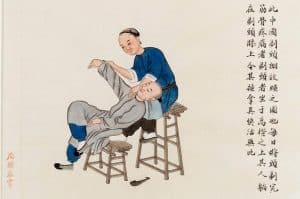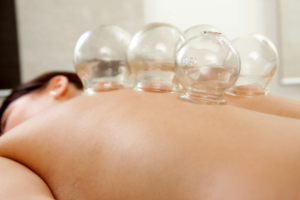What is Chinese massage?
Chinese massage Tuina 推拿 is a manual therapy which represents a complete and major tool for traditional Chinese medicine as well as acupuncture or the pharmacopoeia.
It aims to restore balance to the body and mind by promoting better circulation of the Qi, Blood and body fluids.
Your practitioner will use many manual techniques on the meridians and acupuncture points. It will act on the feet as is the case in plantar reflexology, can perform a cranial massage, a facial massage or massage the stomach (massage Chi Nei Tsang) depending on the case presented to him. He may also resort to various techniques such as the use of chinese cupping, there moxibustion where the Guasha.
As for children and infants, there is a pediatric chinese massage called Xiao Tuina which has its own point system and its own manual techniques.
Access to articles about Tuina
By targeting the acupuncture points, Chinese massage can relieve disorders:
- tendon-muscular: low back pain, muscle tension, pain, contracture, spasm, epicondylitis, sciatica, tendinitis, sprain, fibromyalgia
- joints : osteoarthritis, knee pain, neck pain, back pain, rheumatoid arthritis
- emotional : insomnia, sleeping troubles, headache, stress, anxiety, fatigue, weariness, depression, addiction
- digestive : constipation, diarrhea, indigestion, nausea
- gynecological : period pain, endometriosis
- respiratory : asthma, cough, cold
- of the cardiovascular system : high blood pressure, blood circulation, palpitations

Chinese massage treats several pathologies
Those said to external medicine such as muscle tension, tendinitis or frozen shoulder. The treatment principle will be simple. This will involve activating the circulation of Qi energy so that all tissues are nourished more effectively, which will have the effect of improving healing time.
Then there are the often chronic pathologies known as internal Medicine like the headache, insomnia or constipation. In this case, the protocol applied will be adapted according to the energy assessment which will be carried out beforehand. Depending on the blockages that he finds, the practitioner will act on the meridian system in order to regain balance and harmonize the Qi.

Below are the answers to the questions I am often asked about Chinese massage.
At the start of the session, I ask you various questions about your complaint and your health.interview. Then I examine you in order to be able to establish a balance sheet which will be essential for the future. The session continues with phase during which I massage specific areas in order to relieve the ailments highlighted previously.
Chinese massage is an energetic massage, where the stimulation maybe deep And powerful. To do this, the practitioner asks for the patient's cooperation in order to communicate their feelings so that the intensity of the stimulation can be adapted. It is possible to feel aches the next day, this is the sign that the body is in a regulatory process.
Finally, a debriefing phase allows you to review the sensations you felt during the massage and the need to continue the work, or not, later.
Depending on the nature of the patient's ailments, the session lasts on average between 1 hour and 1 hour 15 minutes.
Tuina Chinese massage is most often carried out on a clothed person. It is therefore recommended to wear loose clothing in order to be able to receive all the techniques, mobilizations and stretching comfortably. As for the relaxation massage, this is done with vegetable oil directly on the skin of the person being massaged who is in their underwear.
The duration of treatment will depend on your energy status, your state of health, the severity of your disorder, your medical history and other factors. Generally, 1 to 3 sessions are sufficient but it is possible that a chronic illness that has been present for several months or years requires more sessions before a notable improvement occurs.
On average, it is recommended to do sessions as close together as possible in order to induce the effects of the massage. Once the benefits of massage have been established, the sessions can be spaced out more and more frequently. One session per month is a good rhythm for taking care of your health.
A consultation in traditional Chinese medicine does not replace that of a doctor. On the contrary, you may be asked to consult a general practitioner or specialist in order to obtain medical advice and possibly carry out other care techniques.
The main difference is that the Tuina Chinese massage protocol will adapt finely to the person being massaged, depending on their pathology and state of health. The Tuina massage will target a particular ailment. While the wellness massages, although adapted to the person being massaged in terms of speed and intensity of movements, follow a more general protocol. They will mainly provide overall relaxation.
If you still haven't found your answer, I invite you to ask me the question by email or by phone.
Offer a Chinese massage
You can offer one or more Chinese massage sessions to the person of your choice. If she cannot come to the office Courbevoie, please note that there is also the possibility that the massage can be done at home. I move mainly in the Hauts-de-Seine in 92 (Courbevoie, La Défense, Suresnes, Puteaux, Neuilly-sur-Seine, Rueil-Malmaison...) and on Paris (75001, 75002, 75003, 75004, 75005, 75006, 75007, 75008).
For more information, I invite you to look at the page which presents the massage at home.
I am a practitioner of traditional Chinese medicine, not a doctor: no diagnosis has been established.
The Tuina Chinese massage is not therapeutic in nature and does not replace medical monitoring.
